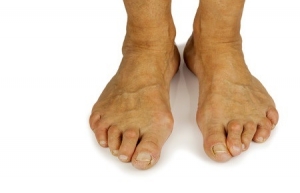Connect With Us
Blogs
Displaying items by tag: Bunions
Dealing with Bunions
A common condition that we treat at Superior Foot & Ankle Center is the bunion. A bunion, also known as hallux valgus, is an enlargement of the joint at the base of the big toe which forms when the bone of the joint moves out of place and toward the second toe. The further the toe moves the more the framework of the foot becomes deformed and the bigger the bump that forms on the outside of the toe grows. Bunions can cause considerable pain due to all the weight and pressure put on the big toe as you walk and also from the friction that occurs from shoes rubbing on the protrusion. Other symptoms include inflammation and redness, a burning sensation and numbness. Bunions are progressive. Over time, corns or calluses may form on the toe and the range of motion may become limited.
What’s Behind a Bunion?
Bunions form as a result of an abnormality in the structure of the foot which shifts the forces exerted on the joints and tendons in a way that causes instability and ultimately deformity of the joint. Possible reasons for this include:
- Inherited faulty foot mechanics
- Neuromuscular disorders
- Consistently wearing shoes that have narrow toe boxes and/or are too small, squeezing the toes together in an unnatural position
Treatment and Relief
Many people suffer unnecessarily with bunions. It is true that when bunions are severe and causing serious disability and pain that surgery may be needed to remove the bony enlargement and correct the alignment of the toe joint. Before reaching that point, however, there are several conservative treatment options available, including:
- Changing to shoes with wide toe boxes and avoiding high heels
- Padding and/or taping the toe to reduce pain and keep the toe in its correct position
- Ice packs, anti-inflammatory medications and cortisone injections to lessen pain and inflammation
- Custom orthotic inserts for your shoes to correct toe alignment and take pressure off the painful area
You won’t know what relief is available until you have one of our podiatrists, Dr. Victoria Foley and Dr. Constance Omelas examine your bunion and determine its severity. If you are suffering with bunion symptoms, contact our Long Beach office by calling 562-420-9800 for an appointment today.
What to Do to Keep Your Child’s Feet Healthy
Being a parent involves caring for your child in every way you can. You make sure they are eating the right food, being nice to others, and staying out of any trouble. However, it is also important that you are watchful of their health, more specifically their foot health. Maintaining good foot health in childhood is important in preventing later conditions in life from happening. As children continue to develop, their feet require different techniques of care. Here are some various ways in which you can help your child’s feet stay healthy.
A baby needs a lot of care and attention overall, but the importance of their feet should never be forgotten. Before a baby turns one, their feet change and develop greatly. It is important that during this time, a mother avoids putting tight socks on their child. She should also encourage movement of their feet so the baby can begin to feel more comfortable using them.
As a baby enters the toddler years of his or her life, they are begin to walk around. When your baby begins to take those first steps, it is crucial that they are wearing protective shoes on their feet. As a mother that is observant of your child’s feet, you may notice changes in them. This is completely normal as the feet are becoming susceptible to the activity of walking. It is normal for a toddler to be a bit unsteady or to “walk funny” at first.
When your child grows out of their toddler years, it is important that you begin to show him or her how to care for their feet on their own. Practice with your child proper hygiene in order to prevent foot fungus or infection. Since children are constantly on the move, it is crucial to be cautious of any accidents or injuries that might occur. If an injury occurs, it is advised that you take your child to be examined by a doctor immediately. Since your child is still growing, particular injuries can shift the way in which a bone or other important part of the foot is developing.
Babies and kids are always changing and growing. Your job as a parent is to make sure they stay healthy and making sure they are properly maintained. This involves proper foot care and making sure the feet stay healthy. Following this guide, your child can live a long and happy life.

